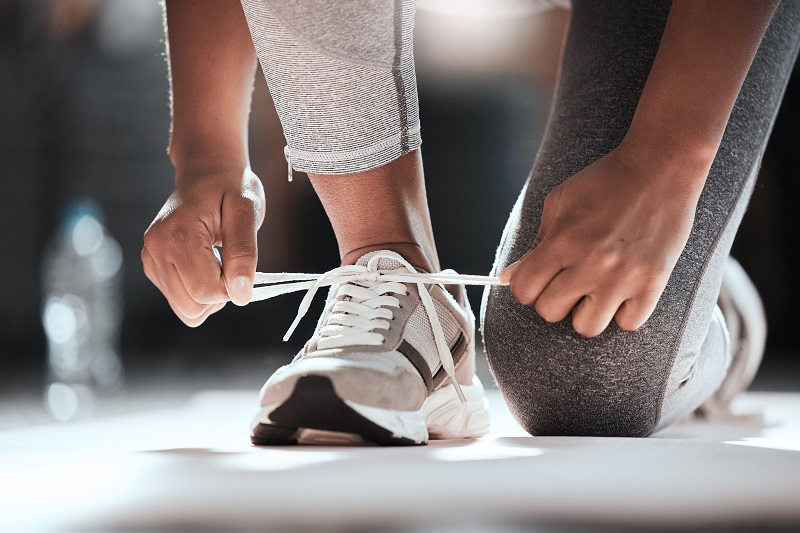How Can Sneakers Help Relieve Foot Pain?

July 20, 2022
Those designer shoes might complete your outfit, however, shoes that don’t offer ample support can harm your foot health.
“Wearing sneakers may help alleviate foot pain and pressure that can develop on the ball of the foot when women wear heels. Even for lower heeled shoes, sneakers can be a welcome change,” says podiatric surgery specialist Demetrios Econopouly, DPM.
Here are some of the ways that sneakers may relieve foot pain:
- Adequate toe room: may help to relieve bunion pressure and prevent painful corns.
- Comforting shock absorption: Cushioned sneakers may also help to alleviate age-related pain that can develop when the fat pads on the bottoms of the feet thin out, providing less natural cushioning.
- Arch support: People with flat feet or fallen arches may benefit from wearing sneakers with arch support. A podiatrist may recommend insoles or personalized orthotics that may provide even greater arch support.
- Reduce plantar fasciitis pain: Comfortable sneakers won’t cure plantar fasciitis, a common cause of heel pain, but they may help to minimize the pain while someone undergoes treatment.
- Aid in arthritis pain: Sneakers with “rocker soles” – curved soles at the heel and toe, which encourage more fluid motion – may help to relieve arthritis pain, because they encourage smoother gait.
When you’re shopping for sneakers to relieve foot pain, keep these guidelines in mind:
- Shop in the late afternoon. Your feet swell over the course of the day, so if you buy sneakers early in the morning, they may be too tight to accommodate your feet by evening. Bring along the socks that you’ll wear with the sneakers to best assess the fit.
- Cater to your needs. How will you use your sneakers? If you’ll be walking, go with walking shoes, not tennis shoes or running shoes. Cross-trainers may be ideal if you participate in a variety of sports.
- Think beyond the number. Are you convinced that you’re a lifelong size 8? Your feet may become longer or wider over time. Periodically reassess your shoe size, the way that you reconsider your pants size. Gravitating toward what you’ve always worn may harm your feet.
- Heed the heel. For optimal support, sneakers should hug your heel comfortably. Don’t buy sneakers if your heel pops out of them, and never wear backless sneakers; they won’t keep your foot stable, and they may change your gait, leading to problems.
- Promote wiggle room. Make sure that you have room to wiggle your toes around when you lace up the sneakers; otherwise, they’ll be too tight. And remember that sneakers shouldn’t be “broken in” – they should feel good when you try them on.
- Be flexible. Some brands fit people differently, so don’t be hesitant to try on sneakers that are half a size or a full size bigger or smaller.
- Consider outside help. Some people benefit from wearing insoles or orthotics, which may provide arch support, help minimize plantar fasciitis pain or address other problems. If you’re planning to use insoles or orthotics, shop for sneakers with removable insoles, so you can swap them out for your prescription or over-the-counter inserts.
“Fortunately for people with foot pain, there are countless stylish sneakers on the market at all price points, so it’s still possible to make a fashion statement with your feet without sacrificing your foot health,” concludes Dr. Econopouly.
Next Steps & Resources:
- Meet our source: Demetrios Econopouly, DPM
- To make an appointment with Dr. Econopouly, or a doctor near you, call 800-822-8905 or visit our website.
The material provided through HealthU is intended to be used as general information only and should not replace the advice of your physician. Always consult your physician for individual care.
Find a doctor near me
Clinical Contributors
Should I Stop Cracking My Knuckles & Back?

Stop cracking your knuckles & back? Learn why from Drs. Katt & Lopez. Avoid joint pain; get expert advice. Call 800-822-8905.
Partial vs. Full Knee Replacements

Partial vs. Full Knee Replacements: Dr. Cahill explains the differences and helps you find the best knee surgery option. Call 800-822-8905 to learn more.
Find a doctor near me

Why Do Your Knees Hurt When You Squat?
Knee pain when squatting? Learn why from Dr. Russoniello and find relief. JFK University Medical Center offers expert care. Call 800-822-8905.

How to Protect Yourself From Common Sports Injuries
Sports and physical activities bring plenty of benefits, from improving physical and mental health to relieving stress to helping with weight management. But they could also put you at risk of injury if you’re not careful.

